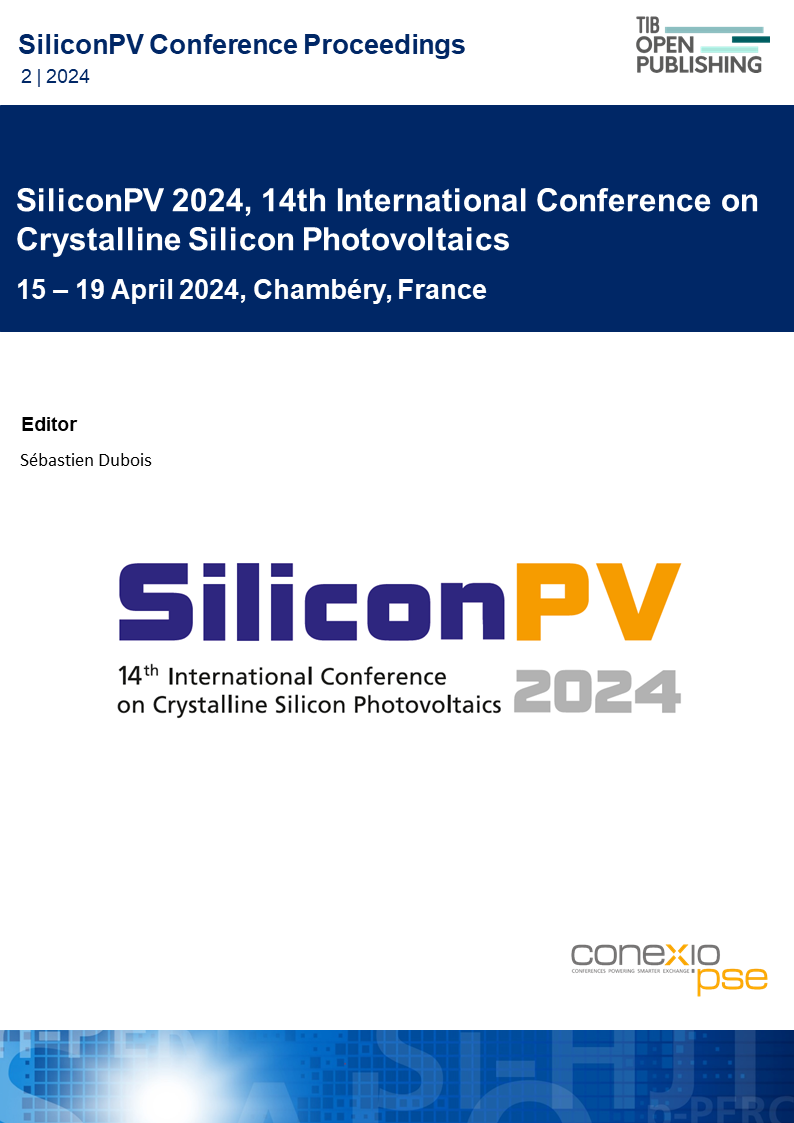Impact of AlOx Capping Layer Thickness for Edge Passivation of TOPCon2 Shingle Solar Cell
DOI:
https://doi.org/10.52825/siliconpv.v2i.1308Keywords:
Shingle Passivation, AlOx Capping, TCOAbstract
This work aims at understanding the short circuit current density losses observed on TOPCon² solar cells after AlOx layer deposition and annealing. This process is the most considered for edge passivation of shingle solar cell, who suffer from heavy edge recombination losses after cutting procedures. Our solar cells feature Transparent Conductive Oxide (TCO) layers at the front and rear sides, on top of which the AlOx edge passivation layer is deposited during Atomic Layer Deposition (ALD) process. We focus on the effect of the AlOx layer thickness and the annealing conditions on the optical and electrical properties of the front AlOx/TCO stack. It is found that annealing of thick AlOx layers induce an increase of free carriers’ concentration in the TCO layer, resulting in additional parasitic absorption. Thinner AlOx layer and/or cooler annealing condition would limit this phenomenon, however rising a compromise with the shingle edge passivation goal. Indeed, we see that applicated on the TOPCon² shingle solar cells, less current density loss comes along lower edge passivation level.
Downloads
References
D. M. Fischer, « ITRPV PV CellTech, Berlin, March 15, 2023.
N. Klasen et al., 7th Workshop on Metallization and Interconnection, Konstanz, p. 36, oct. 2017.
D. Tonini et al., Energy Procedia, vol. 150, p. 36‑43, sept. 2018, doi: https://doi.org/10.1016/j.egypro.2018.09.010.
M. Mittag et al., in 2017 IEEE 44th PVSC 2017, p.1531‑1536. doi: https://doi.org/10.1109/PVSC.2017.8366260.
J. Zhao et al., IEEE Electron Device Lett., vol. 18, no 2, p. 48‑50, févr. 1997, doi: https://doi.org/10.1109/55.553040.
A. Fell et al., IEEE J. Photovoltaics, vol. 8, no 2, p. 428‑434, mars 2018, doi: https://doi.org/10.1109/JPHOTOV.2017.2787020.
V. Giglia, et al., in 37th European Photovoltaic Solar Energy Conference and Exhibition, online, France, sept. 2020
W. Li et al., Adv Energy and Sustain Res, vol. 4, no 2, p. 2200154, févr. 2023, doi: https://doi.org/10.1002/aesr.202200154.
P. Baliozian et al., IEEE J. Photovoltaics, vol. 10, no 2, p. 390‑397, mars 2020, doi: https://doi.org/10.1109/JPHOTOV.2019.2959946.
E. Lohmüller et al., Progress in Photovoltaics, p. pip.3680, févr. 2023, doi: https://doi.org/10.1002/pip.3680.
B. Martel et al., Solar Energy Materials and Solar Cells, vol. 250, p. 112095, janv. 2023, doi: https://doi.org/10.1016/j.solmat.2022.112095.
F. Dhainaut et al., EPJ Photovolt., vol. 14, p. 22, 2023, doi: https://doi.org/10.1051/epjpv/2023013.
S. Shi et al., Advances in Condensed Matter Physics, vol. 2018, p. 1‑10, 2018, doi: https://doi.org/10.1155/2018/7598978.
Published
How to Cite
Conference Proceedings Volume
Section
License
Copyright (c) 2024 Franck Dhainaut, Thibaut Desrues, Benoit Martel, Mickael Albaric, Olivier Palais

This work is licensed under a Creative Commons Attribution 4.0 International License.
Accepted 2025-04-25
Published 2025-05-12
Funding data
-
Agence Nationale de la Recherche
Grant numbers BRIGHTSIDE 22-CE05-0027
